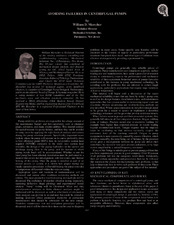| dc.description.abstract | Pump reliability problems are responsible for a large amount of the maintenance budget and lost-opportunity cost at chemical plants, refineries, and many electric utilities. This tutorial outlines the typical reasons for pump failures, and how they can be avoided in many cases by applying the right kinds of analysis and criteria during the pump selection process. Specifically, important issues include where the pump will operate on its curve (preferably close to best efficiency point (BEP)), how its net positive suction head required (NPSHR) compares to the worst case suction head available, the design of the piping hydraulics in the suction and discharge piping close to the pump, and the manner in which piping nozzle loads will be accommodated. Whether or not the ideal pump has been selected, installation must be performed in a manner that avoids hot misalignment, soft foot issues, and thermal bowing of the casing. Once the pump is installed as part of an overall process or system, it is shown how proper startup and steady operation procedures will avoid binding the pump rotor due to temperature differential within the rotor or casing. Appropriate types and locations of instrumentation will be discussed, and various other condition monitoring methods and criteria. The most productive troubleshooting test methods will be discussed. The usefulness of detailed vibration testing (especially operating deflection shape plotting) and experimental modal analysis “bump” testing will be illustrated. When and why rotordynamic analysis or finite element analysis might be performed will be discussed, as well as what kinds of information these analyses can provide to an end user that could be critical in making decisions about premature shutdown or permanent modifications that should be scheduled for the next outage. Predictive maintenance test and evaluation procedures will be discussed, and it will be shown how these can be used to diagnose problems in many cases. Some specific case histories will be discussed in the context of typical or particularly problematic situations that plants have faced, and what types of solutions were effective at inexpensively providing a permanent fit. | en |


